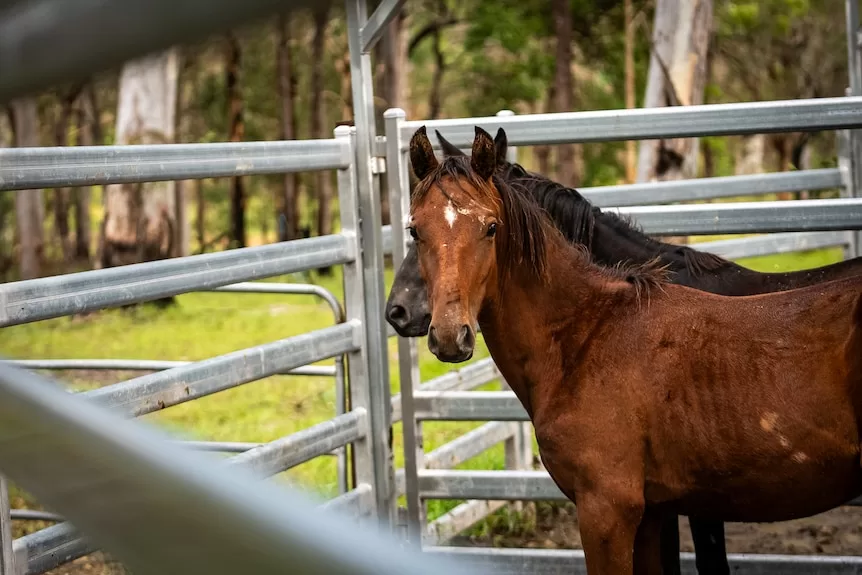- In short: A NSW Upper House inquiry into the aerial shooting of wild horses in Kosciuszko National Park is probing allegations of the operation of an illegal knackery.
- RSPCA’s chief executive says inspectors visited the property on three occasions but missed hundreds of horse remains, which were discovered by Wagga Wagga City Council.
- What’s next? A whole-of-government working group is now investigating the incident and the brumby rehoming program.
The RSPCA missed hundreds of dead horse carcasses during investigations into an alleged illegal knackery, a NSW Upper House inquiry has heard.
The inquiry into the aerial shooting of wild horses in Kosciuszko National Park has organised an extra hearing following the discovery of hundreds of butchered horses at a property near Wagga Wagga last month.
Wagga Wagga City Council said more than 500 horses had been slaughtered over a long period of time at what council officials alleged was an illegal knackery.
RSPCA chief executive Steven Coleman told the inquiry the organisation’s inspectors visited the property on three occasions in late 2023 and early 2024 and said they found remains that “could have equated to maybe 20 horses”.
Mr Coleman told the inquiry that the operator of the property, Adrian Talbot, said the dead horses were all in poor health, were humanely euthanased, and denied he was running an illegal knackery.
He said the inspectors were satisfied with Mr Talbot’s explanation.
“You wouldn’t think it would be hard to miss 500 carcasses,” Mr Coleman said.
He said inspectors also did not investigate the contents of a cool room on the property, which was eventually found to be housing more than 300 kilograms of horse meat seized by the NSW Food Authority.
Wagga-based MLC Wes Fang asked Mr Coleman how his inspectors missed the skeletal remains.
“Right under the nose of RSPCA inspectors were 500 or so horse carcasses on a property that your inspectors didn’t even see,” he said.
Mr Coleman said the inspectors were shown live animals and skeletal remains on around half a hectare of the 8-hectare property.
“Did they look at the other 19 acres [7 hectares]? No, they didn’t,” he said.
Mr Coleman said the RSPCA also did not notify any other agencies of the allegations.
“Should we have referred this to another agency? The answer is yes,” he said.
“This matter has highlighted some gaps.”
Mr Coleman said RSPCA inspectors will undergo further training.
The ABC understands Mr Talbot was asked to give evidence at the inquiry, but declined.
The committee has powers to compel witnesses to appear under the Parliamentary Evidence Act, but is yet to use them.
Parks staff investigated
Some of the remains were of rehomed brumbies, which led to the state government suspending the National Parks and Wildlife Service (NPWS) rehoming program while it conducted its own separate investigation.
NSW Environment Minister Penny Sharpe said Mr Talbot rehomed 260 brumbies and told the inquiry a NPWS staff member had been investigated and cleared of any wrongdoing in relation to the brumby rehoming program.
Mr Sharpe said the department has found evidence of only one unaccounted-for horse out of 2,670 horses trapped under the rehoming program.
The minister said there had been lack of oversight of the rehoming program and there were “clearly issues” with data sharing between agencies.
“I’m definitely concerned that we are where we are,” she said.
“It looks like we’re heading towards an important tightening of the rules around rehoming, what happens post-rehoming, and data sharing.”
‘Pile after pile after pile’
Appearing for Wagga Wagga City Council, general manager Peter Thompson recounted entering Mr Talbot’s property and seeing “pile after pile after pile” of dead horse remains in “various states of decomposition”.
Mr Thompson, alongside other agencies, counted the skulls of the dead horses to come to the 500-plus carcass figure.
He estimates there were 12 to 14 piles of remains across the property, the largest “an area the size of a bus” roughly covered with soil.
“We added up the total skulls in that one pile, which was the biggest pile, and there were over 200 in that pile,” he said.
Mr Thompson said he had been back to the property since the original inspection and the horse remains had now either been completely buried or burnt.
“But on the day we took many, many photos and police took drone footage of the piles. There was a lot of evidence taken before the bones were incinerated,” he said.
Find more local news
Browse for your location and find more local ABC News and information
